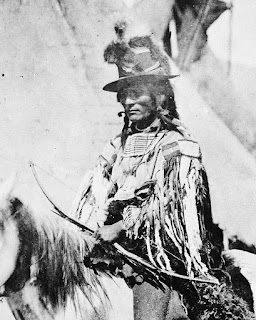Great Leader: Looking Glass of the Nez Perce, 1832-1877
A fighting retreat while bein pursued by an enemy is an extremely complex and dangerous military maneuver. Couple that with harsh conditions and a fighting force burdened with non-combatants and the task becomes even more complex. Chief Joseph of the Nez Perce is often called the Indian Napoleon because his command of the retreat of his people toward Canada in 1877 resembles Napoleon's disastrous Russia Campaign in 1812-13. Napoleon, though, had a fighting marshal and rear-guard commander in Michel Ney, Prince of the Moskowa. Chief Joseph's Ney was Looking Glass, leader of the Alpowai band of the Nez Perce, who lived along the Clearwater River in Idaho.
Looking Glass, 1832-1877, was the son of a Nez Perce chief, known as Flint Necklace or, in some translations, Looking Glass Around Neck, referring to a small mirror carried on a leather string around the neck. His son, Looking Glass, inherited the name and proved his right to his father's chiefship. He was already a noted warrior when the Nez Perce revolt broke out in 1877. The Army, under General Oliver O. Howard, had plans to place the Nez Perce on a reservation. Looking Glass' village was already located within the bounds of the proposed reservation, so he had no reason to go to war and every incentive to stay peaceful to avoid his people's disruption. However, Howard believed that Looking Glass was planning to join Joseph and decided on a preemptive strike.
On July 1, 1877, men under Capt. Stephen Whipple were sent to arrest Looking Glass. They brought with them a Gatling gun, an early and destructive form of machine gun. Someone, no one knows who, fired a shot and the soldiers sprayed the village with the Gatling gun. Looking Glass was able to evacuate most of his people, but the destruction to their lodges and property was irreversible. They had no choice now but to join with Joseph. Looking Glass persuaded Joseph that their best course lay in retreat to Canada along the Bitterroot Mountains. Because of his experience, Looking Glass was the senior battle commander. In August, 1877, his force was surprised at the Battle of the Big Hole and some blamed Looking Glass for the casualties there.
The Nez Perce planned to join the Crow, whom they believe would give them shelter, but the Crow were trying not to direct the wrath of the Army on their own people and refused. The only other option was to join Sitting Bull in Canada. The Nez Perce were 40 miles from the Canadian border when the Army caught up with them in the Bear Paw Mountains of Montana, in September, 1877. The Nez Perce held off their pursuers for five days, but after the Battle of Bear Paw, Joseph believed they should surrender, but Looking Glass and White Bird believed they should fight their way out and keep on toward Canada. White Bird broke through the Army lines and he and his people reached Canada. Looking Glass was killed by a Cheyenne scout as his people tried to do the same. Joseph surrendered, mentioning during his speech that Looking Glass had been killed.
A commemorative marker and hiking trail marks the site of Looking Glass' village today.
Looking Glass, 1832-1877, was the son of a Nez Perce chief, known as Flint Necklace or, in some translations, Looking Glass Around Neck, referring to a small mirror carried on a leather string around the neck. His son, Looking Glass, inherited the name and proved his right to his father's chiefship. He was already a noted warrior when the Nez Perce revolt broke out in 1877. The Army, under General Oliver O. Howard, had plans to place the Nez Perce on a reservation. Looking Glass' village was already located within the bounds of the proposed reservation, so he had no reason to go to war and every incentive to stay peaceful to avoid his people's disruption. However, Howard believed that Looking Glass was planning to join Joseph and decided on a preemptive strike.
On July 1, 1877, men under Capt. Stephen Whipple were sent to arrest Looking Glass. They brought with them a Gatling gun, an early and destructive form of machine gun. Someone, no one knows who, fired a shot and the soldiers sprayed the village with the Gatling gun. Looking Glass was able to evacuate most of his people, but the destruction to their lodges and property was irreversible. They had no choice now but to join with Joseph. Looking Glass persuaded Joseph that their best course lay in retreat to Canada along the Bitterroot Mountains. Because of his experience, Looking Glass was the senior battle commander. In August, 1877, his force was surprised at the Battle of the Big Hole and some blamed Looking Glass for the casualties there.
The Nez Perce planned to join the Crow, whom they believe would give them shelter, but the Crow were trying not to direct the wrath of the Army on their own people and refused. The only other option was to join Sitting Bull in Canada. The Nez Perce were 40 miles from the Canadian border when the Army caught up with them in the Bear Paw Mountains of Montana, in September, 1877. The Nez Perce held off their pursuers for five days, but after the Battle of Bear Paw, Joseph believed they should surrender, but Looking Glass and White Bird believed they should fight their way out and keep on toward Canada. White Bird broke through the Army lines and he and his people reached Canada. Looking Glass was killed by a Cheyenne scout as his people tried to do the same. Joseph surrendered, mentioning during his speech that Looking Glass had been killed.
A commemorative marker and hiking trail marks the site of Looking Glass' village today.




Comments
Post a Comment